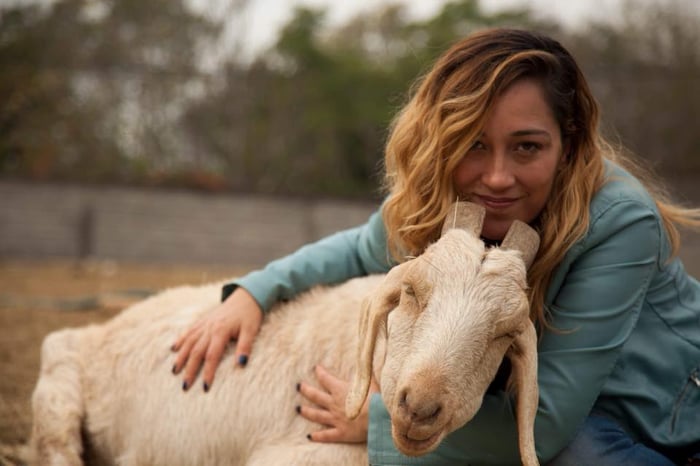 Blanka Alfaro, co-founder of Libres al Fin Sanctuary. Photo: Santuario Libres al Fin
Blanka Alfaro, co-founder of Libres al Fin Sanctuary. Photo: Santuario Libres al Fin
Founded by Blanka Alfaro, Adhara Hernandez, Eli Hernandez, and Gustavo Olvera in 2013, Libres al Fin Sanctuary, located in Nuevo León, Mexico, provides a forever home to rescued farm animals. Libres al Fin is the only sanctuary in the state that rescues farm animals. This Mexican state’s economy largely depends on animal breeding. More recently, however, according to Blanka, the situation has been improving, and an increasing number of people in Nuevo León have been becoming vegan.
Currently, the sanctuary is home to 70 animals. It is one of the many organisations supported by abillion's giving program. This September, we're hoping you consider Libres al Fin when choosing a charity to allocate your donation credits. Since the start of the pandemic, the sanctuary has faced difficulties with fundraising. There have also been less volunteers signing on to work here; volunteers play a big part in maintaining the overall cleanliness of the sanctuary.
We caught up with Blanka to talk about how the sanctuary began, some of her favorite residents, challenges brought about because of the pandemic, and what it’s like being the first farm animal sanctuary in Mexico.
How did the founders meet?
I was working at a non-profit that rescued dogs and cats, and Adhara was an independent rescuer. We helped her find homes for her rescues. Then we started to help farm animals together until we co-founded the sanctuary with Eli Hernandez and Gustavo Olvera.
 Adhara Hernandez, co-founder of Libres al Fin Sanctuary. Photo: Libres al Fin Sanctuary
Adhara Hernandez, co-founder of Libres al Fin Sanctuary. Photo: Libres al Fin Sanctuary
Could you share more about what made both of you start the sanctuary?
We rescued Wicca, this beautiful pig, after she jumped off the truck that was taking her to the slaughterhouse. We knew that we wanted to find her a home, so we had her in a rental place, taking care of her till we found her a permanent place. But it is very difficult to find a home for a pig.
In the meantime, 6 baby goats jumped off a truck on the way to a wet market, so we rescued them also. As they were babies, we placed them at Adhara’s house while giving them the medical care they needed as they were very sick. At that point, we thought we needed to do something for these brave animals that were already saving themselves. So we got together, the four who were taking care of them (Gustavo, Eli, Adhara, and Blanka), and decided that we had to take the big step forward and start the sanctuary.
Did you know you were starting Mexico's first farm animal sanctuary?
Yes, it was a big responsibility because these habitants will live here forever, and we didn’t have any other sanctuary to turn to for help. Adhara and I were lucky enough to have been interns at Woodstock farm sanctuary, where we learned so much. We also had help from Laura, the founder of Santuario Vegan in Spain, and Susie Coston from Farm Sanctuary. They have all been our mentors, so we were ready to be the first farm animal sanctuary in Mexico.
Can you tell us how the sanctuary has grown over the years?
At the start of this adventure, we were just five people working here, and now we are nine people supporting the sanctuary, each in our own unique way! In 2017, we moved to the place that we are currently renting. The new location gives us the freedom and security to keep operating. The original site was one we borrowed, and we were always worried about being kicked out. Now, because we are renting, we have a binding contract that guarantees that animals will be in a stable and reliable situation. The number of inhabitants has grown too, although we try to remain small in size to fulfill all the animals' needs ranging from food to veterinary care.
 Photo: Libres al Fin Sanctuary
Photo: Libres al Fin Sanctuary
This sanctuary is located in the state of Nuevo León, a region which depends on animal exploitation for its economy. Have there been positive changes in the local society since you opened?
Nuevo León is a place in Mexico known for its high meat consumption, but recently, it's also experiencing massive growth in the number of vegans and vegetarians. Right now, there is a large variety of vegan products and restaurants that weren't available previously.
I believe part of this change is due to the sanctuary incorporating volunteer work from the community. People have started to let us know that they have changed their eating habits. We have even had some volunteers turn vegan! Another way the sanctuary impacts the community is through our social media, where we showcase how we interact with the animals and give updates on their health. This way, it helps the community get to know the animals and grow fond of them.
Do you feel that people in your area are generally aware of animal welfare issues?
Unfortunately, Mexico is known for its animal cruelty, including dogs and cats, as the laws are not enough to protect them, and those that exist do not get followed. If we're talking about farm animals, there are live markets where animals get slaughtered without desensitization or health practices. Not to mention clandestine slaughterhouses. There is still a lot of work to do to educate people about animal welfare in our country. We believe that the sanctuary is very important because it shows that a world of compassion is possible; people can see in our social media how animals interact and how they develop unique bonds just as humans do. Our animals are ambassadors of their species showing they have personalities and the right to live in peace.
 Animals at the sanctuary. Photo: Libres al Fin Sanctuary
Animals at the sanctuary. Photo: Libres al Fin Sanctuary
We love that the name of the sanctuary is "Free at Last"? Is there any story around choosing the name and what it means to you?
We wanted to have a name that represents and reflects the life of our habitants, and one of our main goals is that they can live as free as they can be. They can make their choices every day, opposite to how they lived before. So, "Free at Last" represents this, and we think the name itself can make you smile.
 Photo: Libres al Fin Sanctuary
Photo: Libres al Fin Sanctuary
What does a typical day in the sanctuary look like for both of you?
A typical day begins with the roosters singing around 7am. Around the same time, Cleveland, the donkey, makes it known that he is ready for breakfast. We start giving food to the hens and roosters who wake up early too. After that, we serve breakfast to the rest of the animals. We give hay and alfalfa to sheep, goats, and Cleveland using a wheelbarrow. Afterward, we serve plates with vegetables and pellets for the pigs, feed our turtles, and give breakfast to dogs and cats. We check if all the waters are filled and fresh, and once everybody gets fed, we have our breakfast.
After the hens and roosters have eaten, we open the doors to their shelter so they can spend their day roaming in the sanctuary. We take some time to observe to make sure nothing is strange or unusual in the animals. We inspect them from time to time to ensure nothing is physically wrong. We spend some time with them but try not to intrude on their daily routine.
Over the weekends, we get all their food, including hay, alfalfa, fruits, and vegetables, from various shops and stores. We dedicate these two days for maintenance and construction because most of our volunteers work during the week, and the weekend is the only free time they can help out. In the afternoon, we start serving dinner and refill their water. When the sun is almost down, the hens and roosters go back to their shelter, and other animals gather to rest.
What are the biggest challenges you have faced while running the sanctuary?
To deal with many losses of loved ones. Most of the animals become very sick as they come from places that kept them in very poor conditions. Most veterinarians do not know how to heal them. Secondly, as we're renting this place, we're afraid that we will have to move at some point. It has happened before. We had a month's warning to shift from our first location, so we had to move super fast.
Could you share any unique rescue operations that you have been a part of?
The one that stands out happened in August 2014 in the state of Michoacán in Mexico. Over 60 animals were "confiscated" (they were moved to a safer place) by the authorities from where they lived in terrible conditions. It was an unhealthy environment; they were malnourished and starved. Many of these animals had severe injuries and health problems. The fragile ones did not survive, and the situation of others was very delicate.
In Mexico, laws that protect farm animals are practically nonexistent. After a long and complex process (about four months), we convinced the authorities to give us custody for four of these animals: a cow, two sheep, and a goat, whom we have named Santana, Lennon, Yoko, and Pancho. Sadly, Pancho the goat died before we could rescue her.
We brought Yoko and Lennon to our sanctuary. Lennon died a couple of weeks after, as his stomach was filled with garbage and plastic, and this caused organ failure. Yoko was pregnant, and she had Molly. But sadly, Yoko passed away because of the same situation as Lennon. Molly is still with us though and lives happily with her sheep pack.
 Molly being fed by the sanctuary staff. Photo: Libres al Fin Sanctuary
Molly being fed by the sanctuary staff. Photo: Libres al Fin Sanctuary






